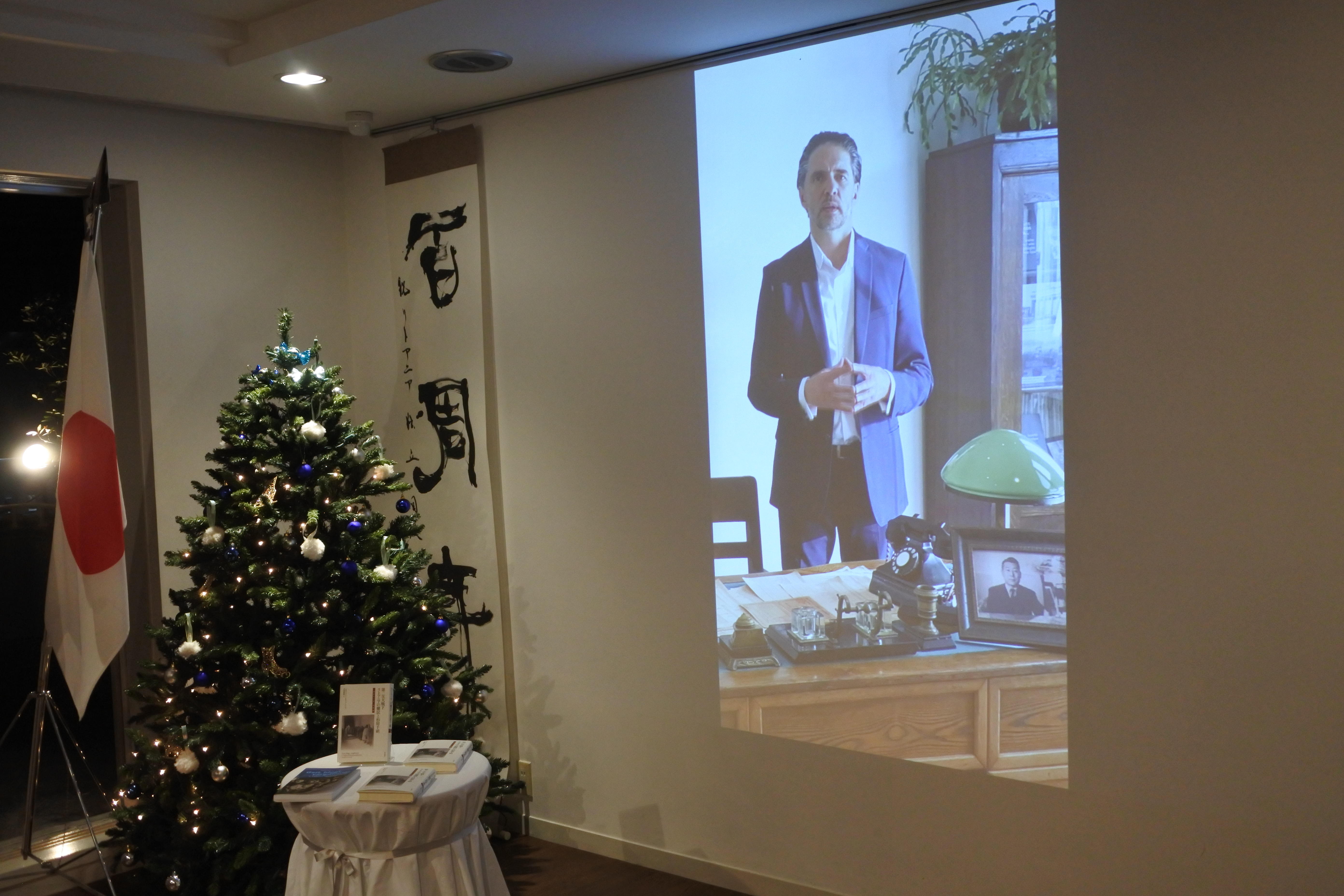トップページ/ニュース 都市情報学部の稲葉教授が解説?監修した翻訳書の出版記念パーティー開催 リトアニア大使館で大使ら交えて
『第二次大戦下リトアニアの難民と杉原千畝―「命のヴィザ」の真相』
 記念写真に納まる(左から)稲葉教授、バルブオリス大使、赤羽研究員
記念写真に納まる(左から)稲葉教授、バルブオリス大使、赤羽研究員
 パーティーに出席した人たち
パーティーに出席した人たち
2020年は「命のヴィザ」で知られる外交官、杉原千畝(すぎはら?ちうね、1900~1986年)の生誕120年、杉原が任地のリトアニアで「命のヴィザ」を発給してユダヤ人を救ってから80年に当たります。同国の歴史学者シモナス?ストレルツォーヴァス博士が2018年に著した「命のヴィザ」に関する本が邦訳され、12月に出版されました。出版記念パーティーは12月9日、東京の在日リトアニア大使館で開かれました。
同博士はリトアニアの旧都カウナスにある杉原記念館の主任研究員。記念館は、杉原が務めた在リトアニア日本大使館の後身です。著書は『第二次大戦下リトアニアの難民と杉原千畝―「命のヴィザ」の真相』。赤羽俊昭?本学総合研究所研究員(国士舘大学講師)が邦訳し、都市情報学部の稲葉千晴教授が解説?監修しました。
リトアニアの歴史学者が著し、邦訳が完成
内容は、リトアニアにおけるユダヤ人難民と、リトアニアで杉原が1940年に取った行動に関する考察です。「命のヴィザ」の陰でリトアニアが国としてユダヤ人難民の生活を支援したことに言及しています。
同博士は2019年に4カ月間、外国人招へい研究員として都市情報学部で研究しました。同書では、本学と同学部の同僚への謝辞をつづっています。
パーティーでは、冒頭、ゲディミナス?バルブオリス大使が「杉原は日本社会が誇れる偉人である」などとあいさつ。日本?リトアニア友好議員連盟会長の中曽根弘文参院議員が祝辞を述べました。
稲葉教授は「シモナスさんとは2015年にポーランドのワルシャワで開いた杉原に関するシンポジウムで初めて会い、素晴らしい発表をした。私は彼を2回日本に招き、出版を薦めた。この本に書かれているのでぜひ読んでほしい」と紹介しました。
訳者の赤羽研究員は「シモナスさんのリトアニアへの愛国心が表れている本」と評し、同博士は杉原記念館からビデオメッセージを送りました。
明石書店刊。四六判304ページ、2,800円+税。原書: The Good, the Bad and the Miserable: Chiune Sugihara and World War II Refugees in Lithuania。
大使「杉原は日本社会が誇れる偉人である」
-
 原著と邦訳を手にあいさつするバルブオリス大使
原著と邦訳を手にあいさつするバルブオリス大使
-
 ビデオメッセージを寄せたストレルツォーヴァス博士
ビデオメッセージを寄せたストレルツォーヴァス博士
-
 邦訳までの経緯を話す稲葉教授
邦訳までの経緯を話す稲葉教授
-
 原著と邦訳を手に著者との縁を語る稲葉教授
原著と邦訳を手に著者との縁を語る稲葉教授
The role of Lithuania in Sugihara’s Rescue Story in 1939-1940
ストレルツォーヴァス博士は12月3日、杉原を顕彰する国際シンポジウムにZoomで参加し、「杉原のユダヤ人救出とリトアニアの役割1939-1940年」と題して講演。ドイツがポーランドに侵攻して第二次世界大戦が勃発した1939年9月から、リトアニアがソ連に占領された1940年6月までのユダヤ人難民のカウナスでの生活ぶりを紹介しました。その上で、ポーランドからユダヤ人がカウナスに逃げた理由や、彼らが「命のヴィザ」で出国するまでのリトアニアの手厚い援助に光を当てました。
レジュメは以下の通りです。
In 2020 we know already what happened in Europe 80 years ago. The events that then took place in Europe were of such importance and influence, bringing such irreversible losses that no other event can be equated to them. It all started with a reluctance to help and an inability to prevent tragic events. After the most influential states of the world had turned away from Jewish refugee problem after Evian in 1938, it was clear that there would be no need to wait long for the consequences. European Jews were left in the dark, their fate did matter to minority and usually it was an acceptable domestic and foreign policy agenda. The aggression against Poland came out as the result of a long silence and reconciliation policy. At the end of the summer of 1939, it seemed that Germany and the Soviet Union could do as they pleased and nothing could stop them. As the war broke out in September 1939, thousands of refugees ?ew toward Lithuania from conquered Poland: 14,000 Jews, 18,000 Poles, 14,000 internee soldiers. They were trying to ?nd safe shelter for themselves and members of their families from war. Refugees arrived into Lithuania escaping territories occupied by Nazis and in the same way - leaving territories occupied by Soviets. In the fall of 1939, Jewish refugees who found themselves in Lithuania tended to settle in the culturally and linguistically familiar district of Vilnius. With support of Lithuanian State, the Committee to Aid Jews was set up in Vilnius. Financial support of Lithuanian State, international organizations and Poland’s allies - France and England were very important in this case. Refugees were supplied with nutrition, clothing, housing, childcare, operated canteens, tailor shops and dormitories. Jewish refugees lived peacefully in Lithuanian Republic until it was occupied by Soviet Union in June, 1940. There were no single cases of anti-Semitic or anti-refugee violation registered in Lithuania. It is usually not mentioned in academic sources that Jewish refugees did not try to leave Lithuania until summer 1940. Unfortunately, 9 months of refugee life in Lithuania has been forgotten. However, it was (and still is) the key factor that refugees spent this time full of events in Lithuania until summer when they were rescued by Sugihara.
Simonas Strelcovas




